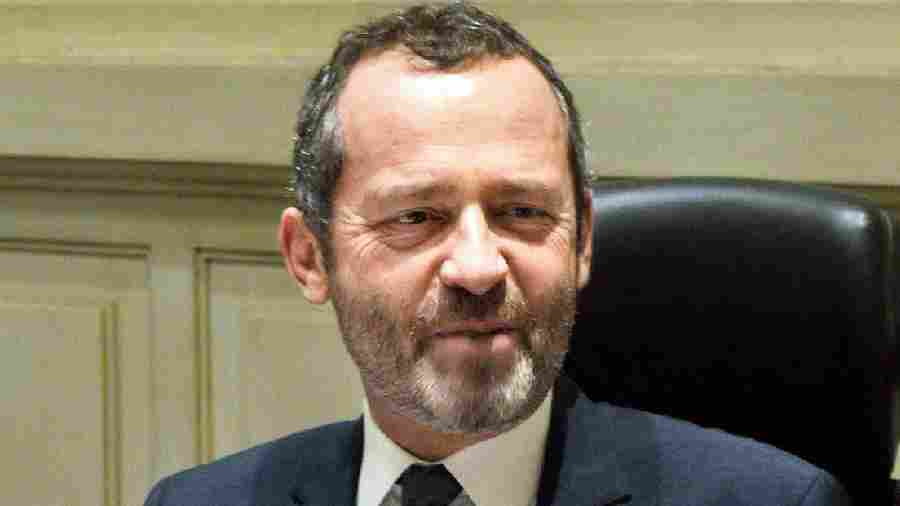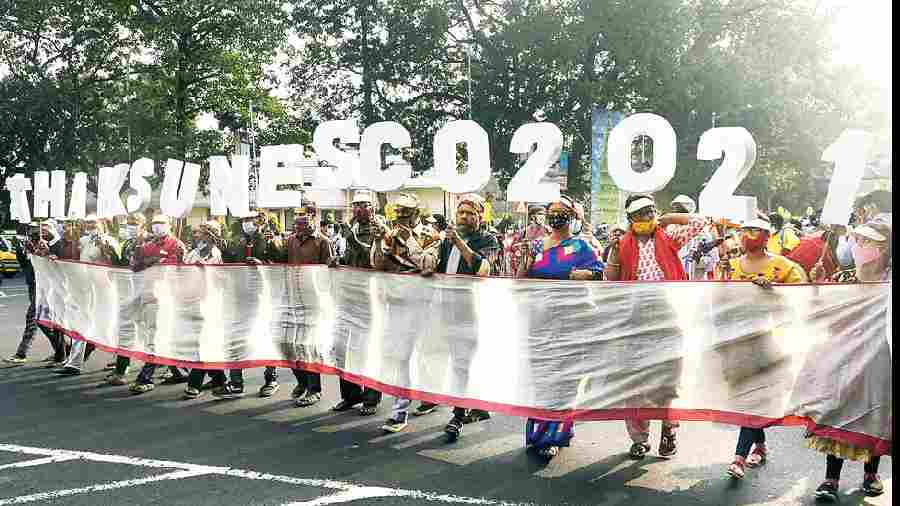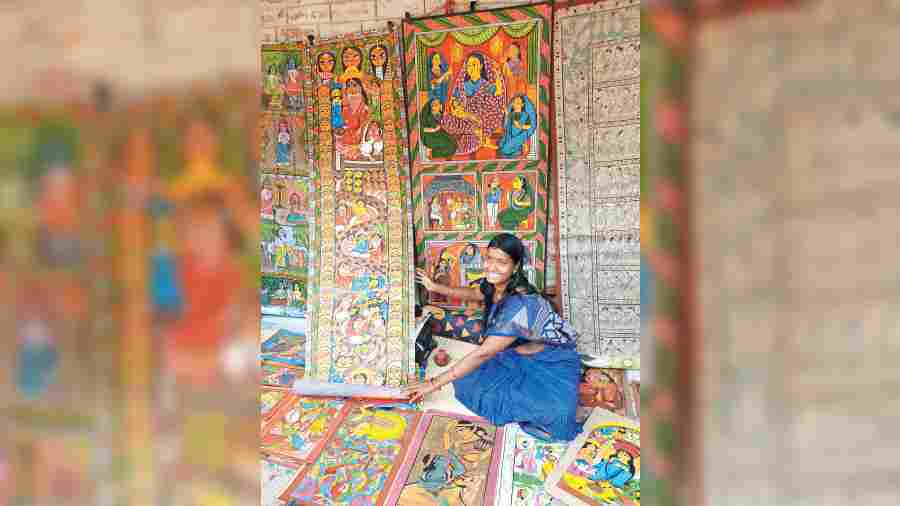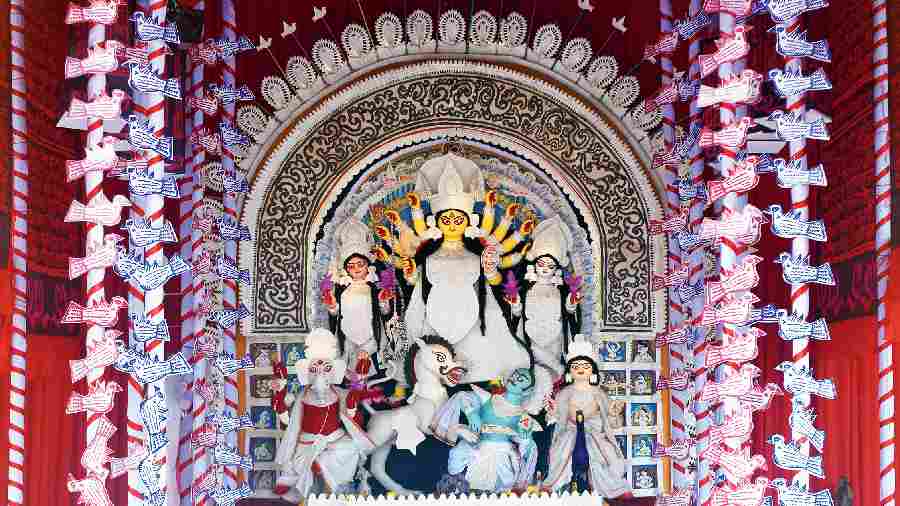Durga Puja 2022 will be the first celebration of the festival after it was recognised by Unesco as Intangible Cultural Heritage, but the organisation’s more involved with Bengal than that, says Eric Falt
Eric Falt, the director of the Unesco cluster office in Delhi, was in Kolkata on a short trip when The Telegraph caught up with him to discuss Durga Puja, inscribed recently on the Unesco’s Representative List of Intangible Cultural Heritage (ICH) of Humanity, but found him involved in much more in Bengal.

Eric Falt Debasmita Bhattacharjee
Thanks to Unesco for bringing so much joy to the city after two harrowing years.
I was very pleasantly surprised to see the extraordinary level of enthusiasm in Calcutta and West Bengal in general, and in the whole of India, for this inscription. We were informed through those who supported the candidacy and the media. It was quite extraordinary to see thousands of people in the streets of Calcutta celebrating with Unesco signs.
Incidentally, as a Puja researcher, I was one of the signatories to the letter from stakeholders that was sent with the nomination dossier to the Unesco.
That actually is the best when there’s sort of a holy alliance between those who need to put forth the nomination officially. It starts with the chief minister, the mayor and other officials but also civil society and the private sector. This (Durga Puja nomination) is a very rare case where everybody seems to be on board.


The Unesco thanksgiving rally in December 2021 in Calcutta. Pictures: TT Archive
Were you in India during the 2017 inscription?
Of Kumbh Mela? No. I arrived right after. But I remember the enthusiasm that there was. This time it has gone to a different level. There’s extraordinary pride. I had a chance to interact briefly with the chief minister (Mamata Banerjee) and she is herself very mobilised. It’s very rare to see everyone embracing a nomination like this.
You were part of a panel at the Bengal Global Business Summit last April.
Yes, it was on cultural heritage and creative economy. I mentioned the Durga Puja but more so the project that we’ve had since 2013 with MSME (Ministry of Small and Medium Enterprises), whereby we support up to 25,000 practitioners of local art forms. In the next instalment, we’re going up to 50,000. It was the only one of its kind until Rajasthan also started something similar. Together with the government, we identify and promote local art forms, mostly in rural communities. I often quote the example of Pingla (in West Midnapore), where we started the project. Till a few years ago, only two or three older men were practising patachitra and it used to be a very disadvantaged rural community. We could ensure a generational transmission to, in this case, women. There are young women now, who live off patachitra and have travelled the world to showcase their art.

At Pingla village in West Midnapore, a Patachitra Folk Art Centre has been developed as part of Rural Crafts Hubs, a project supported by Unesco and the department of micro, small and medium enterprises and textiles, Government of West Bengal. Picture courtesy Eric Falt/Unesco
So you also get involved on the ground?
It’s a team effort funded by the MSME, which is endorsed and implemented through Unesco. The NGO Contact Base is doing the work. I’ve been to Pingla twice. I’ve brought ambassadors and decision-makers to show them how investment in local art forms can change the life of local communities. There’s a tendency for young people to migrate to cities in search of a livelihood. Projects like these can help anchor them in the villages where they were born.
Which art forms are you supporting?
We support several from West Bengal — patachitra, dokra, raibeshe and baul musicians. The pandemic has taken a heavy toll on the creative economy, especially the performing arts and crafts people. India has probably more intangible cultural heritage practices than any other country, but it’s often very poorly inventoried. We’re working with the Government of India to make sure that these art forms are properly inventoried and recognised. The cultural sector has become so important in the overall economy of India, which has one of the largest youth groups in the world. All these young people will need jobs. This is a solution — invest in culture. The return will be manifold to the people.
It’s true that India has not been careful about inventory. China has 42 ICH listings.
Perhaps China started to see the value of heritage a bit earlier. But it is not a competition. I think India now sees the importance of better preserving its cultural heritage. There’s a lot more investment. There’s intense competition at the national level because you can only get one site inscribed every year. Up till now, West Bengal has the Darjeeling Himalayan Railway, which is part of a series nomination (Mountain Railways of India), and the Sunderbans. Santiniketan is proposed for inscription. If it is accepted, it will be the third from West Bengal. I welcome this interest in ICH as there’s a lot more to ICH than monuments. This is the living heritage of the country. The ICH list is representative. The 13 elements are only a tiny sliver of what India has to offer. There are thousands of art forms that are just as important as the ones on the list. India started a bit after but is catching up. We’ve had three festivals in a row for India — Navroz, jointly with other countries, Kumbh Mela and now, Durga Puja. Personally I prefer to look at performing arts and traditional craftsmanship. There’s a lot more originality there.
Any suggestions to promote what you call India’s living heritage?
We are working with the tourism industry to ensure that visitors to India get to know about the country’s living heritage. Many foreign visitors go from their hotel in Agra to the Taj Mahal and leave. But there’s so much more than the monuments! That’s why we’re starting programmes like the one we just launched with the Taj group of hotels whereby if you go to a Taj hotel you will be offered a chance to go on an ICH itinerary. We’re starting relatively small with 10 itineraries around the country. We will soon announce another tourism entity joining this effort. I hope every hotel proposes such itineraries to its visitors. You have a responsibility to showcase the community around.
Santiniketan is on the ICH tentative list.
It is proposed officially as the next inscription. It’s under evaluation by independent experts before it goes to the committee. It’s in the pipeline. If it’s successful it might be the next one. It has followed the entire process of inscription to the tentative list, preparation of the nomination dossier and evaluation. After the evaluation, it goes to the world heritage committee. It’s following the required steps and it’s ahead of anybody else. The rest is not for me to say. The committee meets every year at a rotating location. This year it was supposed to take place in June in Kazan, Russia but has been postponed.
There is talk of the Darjeeling Himalayan Railway being privatised. If that happens can that endanger its heritage tag?
I don’t have the answer. This has been reported to the authorities in Paris and they will look at it.
So an inscription is not forever?
Absolutely not. Last year, there were three properties under scrutiny. The docks of Liverpool was withdrawn from the list. The local people were furious. There was also a threat against the Great Barrier Reef in Australia. Last year, Australia convinced the committee but this issue is coming back again. The city of Dresden had its label removed. So it’s not a label for life.
How do we make Durga Puja as famous as say, the Rio carnival in Brazil?
I’m not sure that it should be the aim. It’s not a popularity contest. I think that it is very much the intention of the government to do so. It’s a complicated issue. For international visitors, sometimes there’s a reluctance to go to mass events like Kumbh Mela. They feel a bit uneasy, especially in Covid times. Mass events are not going to be so easy to popularise. But I only want to stress the positives because I have not seen this outpouring of popular support for an inscription anywhere.
